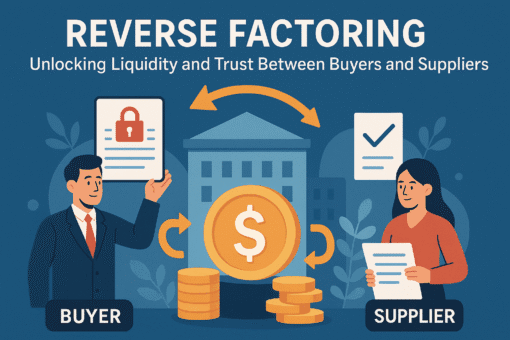Reverse factoring has emerged as a powerful tool in modern trade finance. By improving cash flow, enhancing supplier relationships, and aligning payment terms across the value chain, it enables businesses to operate with more flexibility and less friction.
In a business environment where supply chain resilience and liquidity are under pressure, reverse factoring offers a strategic solution. It allows suppliers to receive early payment on invoices, while buyers optimise working capital. All without the need for traditional borrowing.
This article explores what reverse factoring is, how it works in practice, and why it matters more than ever for finance teams navigating global trade.
What Is Reverse Factoring?
Reverse factoring, also known as supply chain finance (SCF), is a buyer-led financing arrangement that helps suppliers access early payments based on the buyer’s credit standing.
The key feature of reverse factoring is that financing decisions are based on the buyer’s risk profile, not the supplier’s. This shifts the dynamic. It is enabling smaller or less creditworthy suppliers to benefit from preferential financing rates normally reserved for large corporations.
A typical reverse factoring structure involves three parties:
- Buyer: A large company that approves supplier invoices
- Supplier: The vendor delivering goods or services
- Finance provider: A bank or fintech that advances payment to the supplier
By offering early payment options once invoices are approved, buyers support their supply base while extending their own payment timelines, It is creating a win-win situation.
How Reverse Factoring Works
The reverse factoring process follows a straightforward flow:
- The supplier delivers goods or services and issues an invoice.
- The buyer reviews and confirms the invoice.
- The invoice is uploaded to a financing platform.
- The supplier can opt to receive early payment at a discount.
- The finance provider pays the supplier.
- On the invoice due date, the buyer repays the finance provider in full.
This arrangement provides liquidity to the supplier without increasing their debt burden. Meanwhile, the buyer gains working capital benefits and a stronger, more stable supply chain.
Benefits of Reverse Factoring

The rise of reverse factoring reflects its multiple benefits across procurement and finance functions:
- Faster supplier payments: Suppliers receive funds earlier, improving their liquidity position
- Stronger supplier relationships: Buyers build goodwill by supporting supplier cash flow
- Extended payment terms: Buyers lengthen their DPO without harming their vendor base
- Lower financing costs: Suppliers benefit from the buyer’s stronger credit profile
- Reduced supply chain risk: Improved liquidity decreases the likelihood of supplier failure
In essence, reverse factoring turns the payment process into a collaborative financial strategy.
Technology and Platform Innovation

Digital platforms have made reverse factoring more accessible and scalable. Cloud-based solutions now support:
- Automated invoice approval and payment workflows
- e-invoicing and real-time invoice status updates
- API integrations with ERP systems
- Global supplier onboarding and compliance
- Analytics for working capital optimisation
Providers such as Taulia, PrimeRevenue, and Demica offer mature platforms for reverse factoring, while fintech entrants have introduced real-time dynamic discounting and tokenised invoice solutions.
Technology has reduced the onboarding burden and improved transparency across complex supply chains.
Key Challenges in Implementation

Despite its advantages, reverse factoring is not without hurdles:
- Supplier education: Some suppliers may resist the programme or lack awareness
- Onboarding friction: Especially in cross-border environments with KYC and documentation requirements
- Accounting impact: Depending on structure, reverse factoring can trigger reclassification concerns
- Concentration risk: Programmes often rely heavily on the credit strength of a few large buyers
Successful rollouts require clear communication, supplier incentives, and internal alignment across finance, procurement, and treasury teams.
Future Trends in Reverse Factoring

Several trends are redefining the future of reverse factoring:
- Embedded finance integration: SCF tools embedded into procurement and invoicing platforms
- Blockchain smart contracts: Enabling real-time settlement and immutable invoice verification
- ESG-linked finance models: Offering better terms to suppliers meeting sustainability criteria
- AI-driven credit and fraud scoring: Enhancing trust and scalability in global programmes
- Multibank networks: Supporting diverse funding sources to reduce dependency on a single financier
As supply chains become more digital and more distributed, reverse factoring will play a greater role in maintaining liquidity and operational continuity. Reverse factoring is no longer a niche financial product. It is a strategic tool that links procurement, treasury, and supplier relationships into one cohesive system.
By enabling early payments based on the buyer’s credit strength, reverse factoring helps companies support their supply base without increasing their own financial exposure. In today’s volatile economic environment, this approach offers a practical path to strengthening trust, unlocking cash, and building more resilient supply chains.

